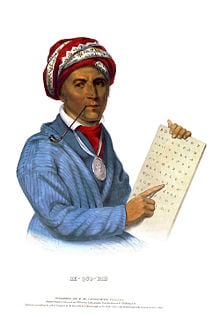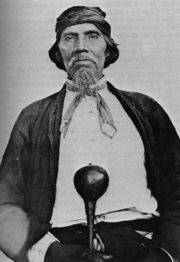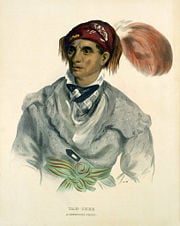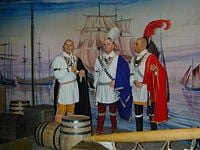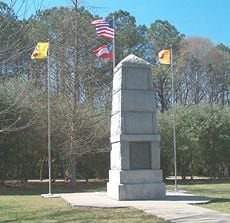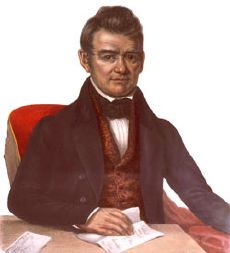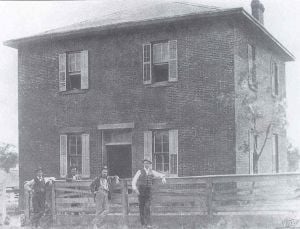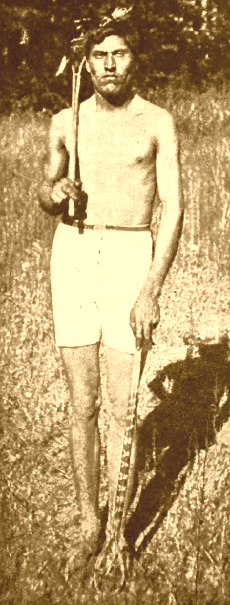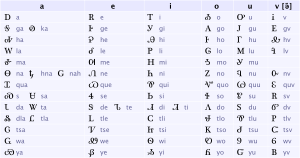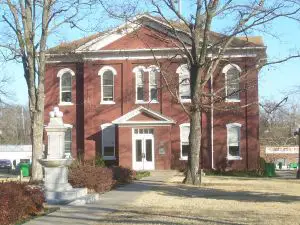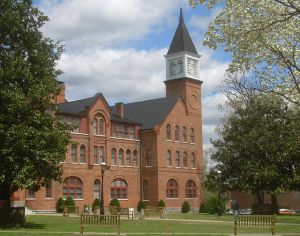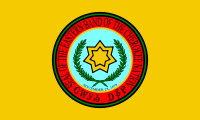Cherokee
| Cherokee á áá´á«á¯ |
|---|
| Sequoyah, 1835. |
| Total population |
| 320,000+ |
| Regions with significant populations |
| United States (Oklahoma, North Carolina, New Mexico) |
| Languages |
| English, Cherokee |
| Religions |
| Christianity (Southern Baptist and Methodist), Traditional Ah-ni-yv-wi-ya, other small Christian groups. |
| Related ethnic groups |
| Tuscarora, Iroquoians, Cherokee, Chickasaw, Choctaw, Muscogee (Creek), and Seminole. |
The Cherokee (á áá´á«á¯, a-ni-yv-wi-ya, in the Cherokee language) are a people native to North America, who, at the time of European contact in the sixteenth century, inhabited what is now the Eastern and Southeastern United States. The Cherokee assimilated many aspects of the American settler culture, significantly their model of government. Due to the syllabary of the Cherokee language developed by Sequoyah in 1821, a written constitution was adopted, literature (including Christian scriptures emerged, and the tribe as a whole became literate. As a result, they are one of the tribes referred to as the Five Civilized Tribes. Nevertheless, most were forcibly moved westward in the 1830s along the infamous Trail of Tears.
| This article contains special characters. Without proper rendering support, you may see question marks, boxes, or other symbols. |
Today, the Cherokee Nation and United Keetoowah Band of Cherokee Indians have headquarters in Tahlequah, Oklahoma. The Eastern Band of Cherokee Indians is located at Cherokee, North Carolina. All three are federally recognized. According to the 2000 U.S. Census, they are the largest of the 563 federally recognized Native American tribes in the United States. They continue to practice many of their traditional ceremonies and dances, keeping those that are sacred closed to the public. Much, however, is open to the wider public regarding their culture and traditions, as well as numerous institutions and businesses that contribute significantly to the economy of their region.
Name
The Cherokee refer to themselves as Tsa-la-gi (á£á³á©, pronounced "Zah la gee" or "Sa lah gi" in the eastern Giduwa dialect or pronounced "ja-la-gee" in western dialect) or A-ni-yv-wi-ya (pronounced "ah knee yuh wee yaw" (western) or "Ah nee yuhn wi yah" (Eastern dialect), literal translation: "Principal People").
The word "Cherokee" may have originally been derived from the Choctaw trade language word "Cha-la-kee" which means "those who live in the mountains"âor (also Choctaw) "Chi-luk-ik-bi" meaning "those who live in the cave country."
It may also have been derived from the same roots as Is-te-cm-us-suk-c-kee from which derived Mus-ko-kee, or Muskogee, which means the "People of the Holly Leaf Confederacy," referring to a shrub found in the Southern States near the Gulf coast known as the "Gulf Holly." Em-us-suk-c-kee is of the same character of construction as the name Uh-chay-la-o-kee, which, abbreviated is rendered Cha-lo-kee, hence is derived the name of "Cherokee"âthe people of the five confederacies being of two distinct national names of one linguistic construction (Gregory 1905). The gulf holly leaf was a medicine used to purify their bodies during religious ceremonies of the feasts, fasts, and festivals of the first fruits, known as "The Green Corn Dance."
History
Unlike most other Indians in the American southeast at the time of contact with Europeans, the Cherokee spoke an Iroquoian language. Since the Great Lakes region was the core of Iroquoian languages, it is theorized that the Cherokee migrated south from that region. Linguistic analysis shows a relatively large difference between Cherokee and the northern Iroquoian languages, suggesting a split in the distant past (Mooney [1900] 1996). Glottochronology studies suggest the split occurred between about 1500 and 1800 B.C.E. (Hopkins).
The ancient settlement of Keetoowah, or giduwa in Cherokee, on the Tuckasegee River near present-day Bryson City, North Carolina, is frequently cited as the original Cherokee City in the Southeast (Mooney [1900] 1996). Europeans wrote of several Cherokee town groups, usually using the terms Lower, Middle, and Overhill towns to designate the towns.
The Lower towns were situated on the headwater streams of the Savannah River, mainly in present-day western South Carolina and northeastern Georgia. Keowee was one of the chief towns.
The Middle towns were located in present western North Carolina, on the headwater streams of the Tennessee River, such as the Little Tennessee River, Hiwassee River, and French Broad River. Among several chief towns was Nikwasi.
The Overhill towns were located across the higher mountains in present eastern Tennessee and northwestern Georgia. Principal towns included Chota and Great Tellico.
Seventeenth century
According to James Mooney, the English first had contact with the Cherokee in 1654. One of the earliest European-American accounts comes from the expedition of James Needham and Gabriel Arthur, sent in 1673 by fur-trader Abraham Wood of Virginia to the Overhill Cherokee country. Wood hoped to forge a direct trading connection with the Cherokee in order to bypass the Occaneechi Indians who were serving as middlemen on the Trading Path. The two Virginians did make contact with the Cherokee, although Needham was killed on the return journey and Arthur was almost killed. By the late seventeenth century, traders from both Virginia and South Carolina were making regular journeys to Cherokee lands, but few wrote about their experiences.
The characteristics of the Cherokee people were later described in the writings of William Bartram in his journey through the Cherokee lands in 1776:
The Cherokeeâ¦are tall, erect and moderately robust; their limbs well shaped, so as generally to form a perfect human figure; their features regular, and countenance open, dignified, and placid, yet the forehead and brow are so formed as to strike you instantly with heroism and bravery; the eye, though rather small, yet active and full of fire, the iris always black, and the nose commonly inclining to the aquiline. Their countenance and actions exhibit an air of magnanimity, superiority, and independence. Their complexion is a reddish brown or copper colour; their hair, long, lank, coarse, and black as a raven, and reflecting the like lustre at different exposures to the light. The women of the Cherokees are tall, slender, erect and of a delicate frame; their features formed with perfect symmetry; the countenance cheerful and friendly; and they move with a becoming grace and dignity (Pritchard 1847, 403-404).
The early trading was mainly deerskins, raw material for the booming European leather industry, in exchange for European technology "trade goods" such as iron and steel tools (kettles, knives, and so forth), firearms, gunpowder, and ammunition. Although selling alcohol to Indians was made illegal by colonial governments at an early date, rum, and later whisky, were a common item of trade (Drake 2001). In 1705 these traders complained that their business had been lost and replaced by Indian slave trade instigated by Governor Moore of South Carolina. Moore had commissioned people to "set upon, assault, kill, destroy, and take captive as many Indians as possible." These captives would be sold and the profits split with the Governor (Mooney [1900] 1996).
Eighteenth century
Of the southeastern Indian confederacies of the late seventeenth and early eighteenth centuries, (such as the Creek, Chickasaw, Choctaw, and Seminole along with whom they became known as the Five Civilized Tribes), the Cherokee were one of the most populous and powerful, and were relatively isolated by their mountainous homeland.
Although there was trading contact, the Cherokee remained relatively unaffected by the presence of European colonies in America until the Tuscarora War and its aftermath. Hundreds of Cherokee joined the British army in North Carolina to defeat the Tuscarora and their allies.
The Tuscarora War altered the geopolitical context of colonial America in several ways, including creating a general Iroquois interest in the south. For the many southeastern Indians involved, it was the first time so many had collaborated in a military campaign and seen how different the various English colonies were. As a result, the war helped to bind the Indians of the entire region together. It enhanced Indian networks of communication and trade. The Cherokee became much more closely integrated with the region's various Indians and Europeans. The Tuscarora War marked the beginning of an English-Cherokee relationship that, despite breaking down on occasion, remained strong for much of the eighteenth century.
The Tuscarora War also marks the rise of Cherokee military power, demonstrated in the 1714 attack and destruction of the Yuchi town of Chestowee (in today's southeastern Tennessee). The Cherokee attack on the Yuchi ended with Chestowee, but it was enough to catch the attention of every Indian tribe and European colony in the region. Thus, around 1715, the Cherokee emerged as a major regional power (Gallay 2002).
In 1715, the Yamasee War broke out. Numerous Indian tribes launched attacks on South Carolina. The Cherokee participated in some of the attacks, but were divided on what course to take. After South Carolina's militia succeeded in driving off the Yamasee and Catawba. The Cherokee's position became strategically pivotal. Both South Carolina and the Lower Creek tried to gain Cherokee support. Some Cherokee favored an alliance with South Carolina and war on the Creek, while others favored the opposite. The impasse was resolved in January 1716, when a delegation of Creek leaders were murdered at the Cherokee town of Tugaloo. Subsequently, the Cherokee launched attacks against the Creek, but in 1717 peace treaties between South Carolina and the Creek were finalized, undermining the Cherokee's commitment to war. Hostility and sporadic raids between the Cherokee and Creek continued for decades (Oatis 2004).
In 1730, at Nikwasi, Chief Moytoy II of Tellico was chosen as "Emperor" by the Elector Chiefs of the principal Cherokee towns. He unified the Cherokee Nation from a society of interrelated city-states in the early eighteenth century with the aid of an unofficial English envoy, Sir Alexander Cuming. Moytoy agreed to recognize King George II of Great Britain as the Cherokee protector. Seven prominent Cherokee, including Attacullaculla, traveled with Sir Alexander Cuming back to England. The Cherokee delegation stayed in London for four months. The visit culminated in a formal treaty of alliance between the British and Cherokee, the 1730 Treaty of Whitehall. While the journey to London and the treaty were important factors in future British-Cherokee relations, the title of Cherokee Emperor did not carry much weight among the Cherokee. The unification of the Cherokee nation was essentially ceremonial, with political authority remaining town-based for decades afterward.
In 1735 the Cherokee were estimated to have 64 towns and villages and 6000 fighting men. In 1738 - 1739 smallpox was introduced to the country via sailors and slaves from the slave trade. An epidemic broke out among the Cherokee, who had no natural immunity, and killed nearly half their population within a year. Hundreds of other Cherokee committed suicide due to disfigurement from the disease.
Beginning at about the time of the American Revolutionary War in the late eighteenth century, divisions over continued accommodation of encroachments by white settlers despite repeated violations of previous treaties, caused some Cherokee to begin to leave the Cherokee Nation. Many of these dissidents became known as the Chickamauga. Led by Chief Dragging Canoe, the Chickamauga made alliances with the Shawnee and engaged in raids against colonial settlements. By 1800 some of these early dissidents had moved across the Mississippi River to areas that would later become the states of Arkansas and Missouri. Their settlements were established on the St. Francis and the White Rivers.
Nineteenth century
In 1815âafter the War of 1812 in which Cherokees fought on behalf of both the British and American armiesâ the U.S. Government established a Cherokee Reservation in Arkansas. The reservation boundaries extended from north of the Arkansas River to the southern bank of the White River. Cherokee bands who lived in Arkansas were: The Bowl, Sequoyah, Spring Frog, and The Dutch. Another band of Cherokee lived in southeast Missouri, western Kentucky, and Tennessee in frontier settlements and in European majority communities around the Mississippi River.
After being ravaged by smallpox, and pressed by increasingly violent land-hungry settlers, the Cherokee adopted a white man's form of government in an effort to retain their lands. They established a governmental system modeled on that of the United States, with an elected principal chief, senate, and house of representatives. On April 10, 1810 the seven Cherokee clans met and began the abolition of blood vengeance by giving the sacred duty to the new Cherokee National government. Clans formally relinquished judicial responsibilities by the 1820s when the Cherokee Supreme Court was established. In 1825, the National Council extended citizenship to the children of Cherokee men married to white women. These ideas were largely incorporated into the 1827 Cherokee constitution (Perdue 2000). The constitution stated that "No person who is of negro or mulatto parentage, either by the father or mother side, shall be eligible to hold any office of profit, honor or trust under this Government," with an exception for, "negroes and descendants of white and Indian men by negro women who may have been set free" (Perdue 2000).
In accordance with the cultural transformation proposed by George Washington and Henry Knox, which involved many treaties and efforts to cooperate with the settlers, including abandoning traditional practices and adopting white ways, the Cherokee, along with the Chickasaw, Choctaw, Creek, and Seminole, earned the title of Five Civilized Tribes (Perdue 2003).
Trail of Tears
Cherokees were displaced from their ancestral lands in northern Georgia and the Carolinas in a period of rapidly expanding white population. Some of the rapid expansion was due to a gold rush around Dahlonega, Georgia in the 1830s. One official reason given was that the Cherokee were not efficiently using their land and the land should be given to white farmers. However there is ample evidence that the Cherokee were adopting modern farming techniques, and a modern analysis shows that the area was in general in a state of economic surplus (Wishart 1995). The Indian Removal Act was signed into effect by president Andrew Jackson in 1830, and the relocation of the American Indians from the Southeast began.
John Ross led the battle to halt their removal. His father had emigrated from Scotland prior to the Revolutionary War; his mother was a quarter-blood Cherokee woman whose father was also from Scotland. John Ross became the chief of the tribe in 1828 and remained the chief until his death in 1866. His position was in opposition to a group known as the "Ridge Party" or the "Treaty Party," so called in reference to the Treaty of New Echota, which exchanged Cherokee land for land in the west, and its principle signers John Ridge and his father Major Ridge. On June 22, 1839, Cherokee extremists executed the signers of the Treaty of New Echota, including Major Ridge, John Ridge, and Elias Boudinot.
Despite a Supreme Court ruling in their favor, many in the Cherokee Nation were forcibly relocated West, a migration known as the Trail of Tears or in Cherokee Nunna Daul Tsunny ("The Trail Where They Cried") and by another term Tlo Va Sa ("The Tragedy"):
Then⦠there came the reign of terror. From the jagged-walled stockades the troops fanned out across the Nation, invading every hamlet, every cabin, rooting out the inhabitants at bayonet point. The Cherokees hardly had time to realize what was happening as they were prodded like so many sheep toward the concentration camps, threatened with knives and pistols, beaten with rifle butts if they resisted (Carter 1976).
Not all of the eastern Cherokees were removed on the Trail of Tears. William Holland Thomas, a white store owner and state legislator from Jackson County, North Carolina, helped over 600 Cherokee from Qualla Town (the site of modern-day Cherokee, North Carolina) obtain North Carolina citizenship. As citizens, they were exempt from forced removal to the west. Out of gratitude to Thomas, these Western North Carolina Cherokees served in the American Civil War as part of Thomas' Legion, which consisted of infantry, cavalry, and artillery. The legion mustered approximately 2000 men of both Cherokee and white origin, fighting on behalf of the Confederacy, primarily in Virginia.
In addition, over 400 other Cherokee hid from Federal troops in the remote Snowbird Mountains of neighboring Graham County, North Carolina, under the leadership of Tsali (á£áµ). Together, these groups were the basis for what is now known as the Eastern Band of Cherokees.
Twentieth century
In Oklahoma, the Dawes Act of 1887 had broken up the tribal land base. Under the Curtis Act of 1898, Cherokee courts and governmental systems had been abolished by the U.S. Federal Government. These various acts were designed to end tribal sovereignty and to pave the way for Oklahoma Statehood in 1907. The Federal government appointed chiefs to the Cherokee Nation, often just long enough to sign a treaty. In reaction to this, the Cherokee Nation recognized that it needed leadership and they convened in 1938 to elect a Chief. They choose J. B. Milam as principal chief, and, as a goodwill gesture, President Franklin Delano Roosevelt confirmed the election in 1941.
W. W. Keeler was appointed chief in 1949. Because the federal government had adopted a self-determination policy, the Cherokee Nation was able to rebuild its government and W. W. Keeler was elected chief by the people, via a Congressional Act signed by President Richard Nixon. Keeler, who was also the President of Phillips Petroleum, was succeeded by Ross Swimmer and then Wilma Mankiller.
Culture
Much of what is known about pre-nineteenth century Cherokee history, culture, and society comes from the papers of American writer John Howard Payne. The Payne papers describe the memory Cherokee elders had of a traditional societal structure in which a "white" organization of elders represented the seven clans. This group, which was hereditary and described as priestly, was responsible for religious activities such as healing, purification, and prayer. A second group of younger men, the "red" organization, was responsible for warfare. Warfare was considered a polluting activity which required the purification of the priestly class before participants could reintegrate in normal village life.
This hierarchy had faded by the time of the Cherokee removal in 1838. The reasons for the change have been debated and may include: a revolt by the Cherokee against the abuses of the priestly class, the massive smallpox epidemic of the late 1730s, and the incorporation of Christian ideas, which transformed Cherokee religion by the end of the eighteenth century (Irwin 1992).
Ethnographer James Mooney, who studied the Cherokee in the late 1880s, traced the decline of the former hierarchy to the revolt (Mooney [1900] 1996). By the time of Mooney, the structure of Cherokee religious practitioners was more informal and based more on individual knowledge and ability than upon heredity. In addition, separation of the Eastern Cherokee, who had not participated in the removal and remained in the mountains of western North Carolina, further complicated the traditional hierarchies (Irwin 1992).
Language and writing system
The Cherokee speak an Iroquoian language which is polysynthetic and is written in a syllabary invented by Sequoyah (áááá±) in 1821. A major source of early cultural history comes from the materials written in Cherokee by the didanvwisgi (Cherokee:ááá á«áá©), or Cherokee medicine men, after the creation of the Cherokee syllabary. These materials were initially only used by the didanvwisgi and were considered extremely powerful (Irwin 1992). Later, they were widely adopted by the Cherokee people.
There are two main dialects in Cherokee spoken by modern speakers. The Giduwa dialect (Eastern Band) and the Otali Dialect (also called the Overhill dialect) spoken in Oklahoma. The Otali dialect has drifted significantly from Sequoyah's Syllabary in the past 150 years, and many contracted and borrowed words have been adopted into the language. These noun and verb roots in Cherokee, however, can still be mapped to Sequoyah's Syllabary. In modern times, there are more than 85 syllables in use by modern Cherokee speakers. Modern Cherokee speakers who speak Otali employ 122 distinct syllables in Oklahoma.
For years, many people wrote transliterated Cherokee on the Internet or used poorly intercompatible fonts to type out the syllabary. However, since the fairly recent addition of the Cherokee syllables to Unicode, the Cherokee language is experiencing a renaissance in its use on the Internet.
Stickball
The contemporary sport of Lacrosse has its origins in a tribal game known as Stickball played by American Indians. The Cherokee called it "little war," da-nah-wah'uwsdi in Cherokee language.
Traditional stickball games were sometimes major events that could last several days with as many as 100 to 1000 men from opposing villages or tribes participating. Rules for these games were decided on the day before. Generally there was no out-of-bounds, and the ball could not be touched with the hands. The goals would be selected as large rocks or trees; in later years wooden posts were used. Playing time was often from sun up to sun down.
Traditionally stickball had many different purposes. Some games were played to settle inter-tribal disputesâthis function was essential to keeping the Six Nations of the Iroquois together. It was also played to toughen young warriors for combat, for recreation, as part of festivals, and for the bets involved.
Beliefs
The Cherokee held that signs, visions, dreams, and powers were all gifts of the spirits, and that their world was intertwined and presided over by the spirit world.
Spiritual beings
The Cherokee believed that every aspect and thing had a spirit presiding over it, but did not hold a belief in multiple gods. All figures identified as 'gods' were simply greater beings in the Cherokee belief whose names were so great there were no English words for them, and thus they were recognized as 'gods' by Englishmen.
However, the Cherokee paid direct respect to and worshiped only the Great Spirit Yowa (a name so sacred that only a priest could say it), who presided over all things and created Mother Earth.
Significant spirits include:
- Sint Holo: The Horned Serpent
- Tsul 'Kalu: Spirit of the Hunt
- Oonawieh Unggi ("the oldest wind"): Spirit of the Wind
- Kana'ti ("The Lucky Hunter"): The Great Hunter
- Selu ("maize"): The Corn Woman
- Nûñnë'hï: The Spirit People
- Thunder Beings
The Thunder Beings were viewed as the most powerful of the servants of the Apportioner (Creator Spirit). There were two classes of the Thunder Beings, those who lived close to the Earth, and the holiest and most powerful of the Thunder Beings who lived in the land of the west beyond the Mississippi River, visiting the people to bring the rains and blessings from the South.
- Ani Yuntikwalaski: Spirits of thunder and lightning (the thunder beings)
- Asgaya Gigagei (Thunder Beings of the West): Spirits of thunderstorms
It was believed that the thunder beings who lived close to the Earth's surface could and did harm the people at times. There were three Thunder Beings from the West in the ancient legends, a greater spirit and his two sons.
Evil
The Cherokee assigned a feminine personality to the concept of the personification of spiritual evil, and named her "wi-na-go" in the ancient language. There is also Nun'Yunu'Wi, an evil spirit monster who preys on humans, and Raven Mocker, the evil spirit of a witch who steals the souls of the dead.
Animals, plants, and disease
The Cherokee believed that all human disease and suffering originated with the killing of animals for improper purposes, and that for each animal killed for pleasure or without proper ceremonies it allowed a new disease to enter the physical world from the spirit world. It was also believed that the plants, in response to witnessing the suffering in the world, made a medicine to cure each sickness that entered the world in order to restore the balance of forces between the two worlds, the physical world and the spirit world.
Ceremonies and dances
Cherokee Dances fall into two basic categories: Social Dances and Religious Dances. Religious Dances always involved pre-selected dancers and complex choreography and steps, and also included at least one social dance at the end of the ceremonies which was open to all of the participants in a ceremonial dance.
Social dances are more prevalent in modern Cherokee societies. Some of these dances were adopted as the result of contact with other Native American tribes.
Cherokee Moons Ceremonies
The Cherokee Moons Ceremonies were the ancient seasonal round of ceremonies practiced during ancient times by the Ah-ni-yv-wi-ya or Cherokee People in the ancient culture. Although the modern Gregorian calendar year comprises 12 months, there are actually 13 cycles or phases of the moon each year. The seasonal round of ceremonies was based on 13 moons, and was considered a necessary spiritual element for growth and encouraged social gatherings among the Cherokee Clans and Cherokee Society in the ancient culture.
Not only does the number 13 correspond to the lunar cycles of the year, but all species of turtle living in the ancient homeland (in fact, all turtle species in the world) have 13 scales on the back of their shells. As a result, Cherokee culture associated the spaces on the back of the turtle with the 13 yearly phases of the moon.
Green corn ceremony
The Green Corn Ceremony (Cherokee:á á¦áªá³ áá·á¤á¥) honors Selu (áá·), the Corn Mother. It is held in late summer, tied to the ripening of the corn crops. The ceremony is marked with dancing, feasting, fasting, and religious observations. In ancient times it lasted for four days. The ceremony was comprised of sacred dances which were performed by the dancers within the sacred circle. The ceremony would begin with all the members of the town going to a running body of water and washing themselves.
The dancers would then perform several rounds of sacred dances which typically lasted from two to four hours. Several dances which symbolized the planting of and harvesting of the corn were performed. Within the dance circle, the dance leader and priest would make offerings to the Thunder Beings and the ancestor spirits as a gesture of thanks for a fruitful corn harvest. The War Dance was also performed by the men. The final dance of Green Corn was the running dance, which would involve not only the sacred dancers, but also the entire assembly in a combined social dance, who would enter the circle and form a snaking, sinuous line of dancers circling the fire.
The dancers used rattles made from gourds which were filled with small rocks and a stick of wood from a lightning struck tree during all the dances with the exception of the war dance and the running dance, which was accompanied by a drum made from a hollow log and covered with deerskin.
Within the sacred circle, a deep pit would be dug and a branch of wood from a tree struck by lightning would be lit and used to bless the grounds for the ceremony. The coals from this thunderwood would be used to kindle the sacred fire in the pit in the center of the circle. During the ceremony all the clan matrons would take coals from the sacred fire in the circle to the new year's home fires. As a symbol of renewal of the new corn harvest tribal members often brought furniture and other items and burned them in the fire.
Minor infractions of the religious and clan law, as well as debts, were typically forgiven during green corn between parties as a symbol of rebirth and new beginnings, which allowed minor deviations from the ancient religious laws in deference to community bonding and cohesion.
Oklahoma Cherokee dance forms
The Cherokee Stomp Dance performed by the Western Cherokee People in Oklahoma is unique within Cherokee culture. The Stomp Dance had its origins with the Creek Indians and was incorporated into the Cherokee culture after their arrival in Oklahoma following their forced removal and arduous trek on the Trail of Tears. In modern times, the Stomp Dance has come to replace the Green Corn Ceremony as the principal gathering of the Cherokee people during the first moon of harvest for the Western Cherokees in Oklahoma.
In the Stomp Dance, the women keep the beat for the dancers, and the men repeat the songs sung by the leader. As the dance begins several hundred people may join the circle as the dance progresses. The dance continues until four rounds of four songs are completed by the Dance Leader, and the dance concludes until the next round. There is normally a five minute break between rounds. The dance continues throughout the entire night until dawn of the next day. The Stomp Dance is a grueling and physically challenging event and almost every Cherokee on the grounds will dance until they drop out from exhaustion. Following and during the dance at dawn an enormous feast of fried pork is consumed throughout the night, along with potatoes, bean bread, and numerous Cherokee traditional dishes. At dawn, a special medicine made from seven secret roots gathered by the seven clans is given to all the Cherokees who completed the dance. This medicine is very invigorating and imbibing excessive amounts typically results in emetic and purgative affects.
During the Stomp Dance, at various rounds in the dance, one of the ancient Cherokee dances, called the running dance, emerges. In this variation, the dancers do not form a spiral into the fire, but form a snaking, sinuous line of people that haphazardly circles the fire. This is a variation of a more traditional social dance performed during the Green Corn Ceremony.
Contemporary Cherokee
Contemporary Cherokee belong to three federally recognized tribes: The Cherokee Nation of Oklahoma (CNO), the Eastern Band Cherokee, and the United Keetoowah tribes. Race and blood quantum are not factors in CNO tribal eligibility. To be considered a citizen, one Indian ancestor listed on the Dawes Rolls is required. The tribe currently has members who share African-American, Latino, Asian, white, and other ancestry. The Eastern Band Cherokee and United Keetoowah tribes do require one quarter Cherokee blood quantum.
Additionally, there is the Southern Cherokee Nation in Kentucky and the Western Cherokee Community in New Mexico.
Cherokee Nation of Oklahoma
Today the Cherokee Nation of Oklahoma (CNO) has judicial, executive, and legislative branches with executive power vested in the Principal Chief, legislative power in the Tribal Council, and judicial power in the Cherokee Nation Judicial Appeals Tribunal.
The modern Cherokee nation has experienced an almost unprecedented expansion in economic growth, equality, and prosperity for its citizens. The CNO, under the leadership of Principal Chief Chad Smith, has significant business, corporate, real estate, and agricultural interests, including numerous highly profitable casino operations. The CNO controls Cherokee Nation Enterprises, Cherokee Nation Industries (CNI), and Cherokee Nation Businesses. CNI is a very large defense contractor that creates thousands of jobs in eastern Oklahoma for Cherokee citizens.
The CNO has constructed health clinics throughout Oklahoma, contributed to community development programs, built roads and bridges, constructed learning facilities and universities for its citizens, instilled the practice of Gadugi (Cherokee: á¦áá©), which means "working together" in a community sense, and self-reliance in its citizens, revitalized language immersion programs for its children and youth, and is a powerful and positive economic and political force in Eastern Oklahoma.
The CNO hosts the Cherokee National Holiday on Labor Day weekend each year, and 80,000 to 90,000 Cherokee Citizens travel to Tahlequah, Oklahoma, for the festivities. It also publishes the Cherokee Phoenix, a tribal newspaper which has operated continuously since 1828, publishing editions in both English and the Sequoyah Syllabary. The Cherokee Nation council appropriates money for historic foundations concerned with the preservation of Cherokee Culture, including the Cherokee Heritage Center which hosts a reproduction of an ancient Cherokee Village, Adams Rural Village (a turn-of-the-century village), Nofire Farms, and the Cherokee Family Research Center (genealogy), which is open to the public. The Cherokee Heritage Center is home to the Cherokee National Museum, which has numerous exhibitions also open to the public.
Today the Cherokee Nation is one of America's biggest proponents of ecological protection. Since 1992, the Nation has served as the lead for the Inter-Tribal Environmental Council (ITEC). The mission of ITEC is to protect the health of American Indians, their natural resources and their environment as it relates to air, land, and water. To accomplish this mission, ITEC provides technical support, training, and environmental services in a variety of environmental disciplines. Currently, there over forty ITEC member tribes in Oklahoma, New Mexico, and Texas.
The Cherokee People performed numerous social and religious dances which have evolved over time as a result of contact with other cultures, the arrival of the horse, gunpowder-based weapons, and forced integration with other cultures due to relocation and removal from the Cherokee homeland. Many of the traditional dances performed in ancient times have been preserved and are still practiced. However, many of these dances no longer serve the same functions as before and are performed only for religious ceremonies or as reenactments of the ancient culture. Some of the dances are now illegal to perform as they traditionally incorporated the taking of human scalps.
The Cherokee Nation participates in numerous joint programs with the Eastern Band of Cherokee Indians. It also participates in cultural exchange programs and joint Tribal Council meetings involving councilors from both Cherokee Tribes which address issues affecting all of the Cherokee People. Unlike the adversarial relationship between the administrations of the United Keetoowah Band of Cherokee Indians and the Cherokee Nation, the Eastern Band of Cherokee Indians interactions with the Cherokee Nation in a unified spirit of Gadugi.
Eastern Band of Cherokees
The Eastern Band of the Cherokee Indians in North Carolina led by Chief Michell Hicks hosts over a million visitors a year to cultural attractions of the 100-square-mile (260 km²) sovereign nation. This reservation, the "Qualla Boundary" has a population of over 8000 Cherokee consisting primarily of direct descendants of those Indians who managed to avoid The Trail of Tears. Together with Harrahâs Cherokee Casino and Hotel, Cherokee Indian Hospital, and Cherokee Boys Club the tribe put over $78 million dollars into its local economy in 2005.
The Eastern Band of Cherokee Indians still perform most of the original dances which slowly evolved over time into unique forms. The Eastern Band still performs the Green Corn Ceremony each year. The Eastern Band has also begun to perform many dances for the general public in support of tourism, some of which formerly were considered sacred dances. However, many of the ancient sacred dances performed by the Eastern Band are still only open to Cherokees and their families, and not the general public.
The United Keetoowah Band
The United Keetoowah Band took a different track than the Cherokee Nation and received federal recognition after the Indian Reorganization Act of 1934. Members of the United Keetoowah Band are descended from the Old Settlers, Cherokees who moved west before the Removal. The tribe requires a quarter blood quantum for enrollment and UKB members must have at least one ancestor listed on the Final Dawes Roll of the Cherokee.
Southern Cherokee Nation of Kentucky
The Southern Cherokee Nation of Kentucky are descended from the "mixed-blood" Cherokees who recognized the treaty signed in 1835 by Major Ridge. The Constitution established by the "Treaty Party" established by Major Ridge was the basis of their constitutional government until a revised constitution was signed in 2009.
After the murder of the "Treaty Party" leaders, including Major Ridge, these Southern Cherokee faced both the opposition of other Cherokee (who blamed them for the loss of Cherokee land in Georgia) and the federal government who sent Cherokee on the Trail of Tears. Chief James Martin, cousin of Stand Watie (principal chief of the Southern Cherokee Nation from 1862 until his death in 1871) led the remainder to Kentucky, where they reunited with other family members who had escaped the Trail of Tears and re-established their nation in Henderson, Kentucky.
In 1893, the Southern Cherokee Nation was officially welcomed to Kentucky and recognized by Governor John Y. Brown. In 2006, Governor Ernie Fletcher paid tribute to the Southern Cherokee Nation for its 114 years of existence in Kentucky. These Cherokee continue to seek legal status as an Indian tribe.
They continue to preserve their historical culture, holding gatherings for significant events throughout the year. They are private celebrations held only for members or invited guests. Membership on the roll of the Southern Cherokee Nation does not require full blood, but only proof of direct descent from Cherokee ancestors.
Western Cherokee Community
The Western Cherokee Community in Albuquerque, New Mexico is a community comprised predominantly of members of the Cherokee Nation, and some United Keetoowah Band Cherokees and their families. The community has existed in New Mexico since the 1940s and 1950s, when large numbers of Cherokee relocated to New Mexico from Oklahoma due to economic issues and hardships. This group has unique dance forms influenced by contact with Southwestern Culture and Southwestern Spanish Influences, although they also perform the traditional Cherokee dances and ceremonies.
A large number of Western Cherokees are members of the Gourd Society and participate in the Gourd Dance in the New Mexico and Four Corners area. Due to the strong influence of the Native American Church in the Southwestern United States, a large number of Western Cherokee also participate with the Native American Church and have adopted many of its dance forms and customs. Each community Gourd Dance typically hosts a large number of dancers and family members.
Cherokee travel to the New Mexico community yearly from Missouri, and perform the traditional ceremonies and dances which are not open to the public and can only be attended by Cherokees and their families. They practice the ancient dance forms and traditional ceremonies for the Green Corn Ceremony and the Cherokee Moons Ceremonies.
The Stomp Dance is performed by the Western Cherokees at the Stokes Stomp Dance Ground which is located in an isolated area of the Cherokee Nation Tribal Lands. The Dance Grounds contain an elevated platform upon which a very large bonfire is kindled after sunset. Women wear traditional Cherokee Tear Dresses, men wear Western blue jeans and cowboy hats with a single Eagle feather in the hat band. The dance leader is a male Cherokee Elder who calls the people to the dance for each round in the Cherokee language. The women wear turtle-shell shakers on both legs, typically three on either side of their legs, or six per leg which are punched with holes and filled with rocks or shot.
Cherokee Freedmen
"Freedmen" is one of the terms given to emancipated African slaves and their descendants after slavery was abolished in the United States. Both before and after the Civil War, some Cherokee intermarried or had relationships with African Americans, just as they had with whites. In this context, "Cherokee Freedmen" includes African slaves and former slaves of the Cherokee Nation before and after the Trail of Tears, and the offspring of the slaves, former slaves, and tribal members. The Cherokee freedmen were first guaranteed Cherokee citizenship under a treaty with the United States in 1866. This was in the wake of the American Civil War, when the US emancipated slaves and passed US constitutional amendments granting freedmen citizenship in the United States.
Famous Cherokees
There have been many famous Cherokees in American history, including Sequoyah, who invented the Cherokee writing system. It was thought for many years that he was the only person to single-handedly invent a writing system, however it has been recently speculated that there was an ancient clan of Cherokee priests who had an older, mostly secret rudimentary written language from which Sequoyah may have gotten inspiration. Many historians speculate that Sequoyah never learned to speak, read or write the English language for various reasons.
Elias Boudinot (1802âJune 22, 1839), originally known as Gallegina "Buck" Watie, was a statesman, orator, and editor. He took the name "Elias Boudinot" from the man who paid for his education. He wrote Poor Sarah, the first Native-American novel. He also started and edited the tribe's first newspaper, the Cherokee Phoenix. He was a missionary who translated the New Testament Bible and hymns into Cherokee with the help of a missionary friend, Samuel A. Worcester. Stand Watie, Buck's younger brother, was a famous frontiersman and the last general of Confederate forces to surrender in the American Civil War.
Will Rogers (1879 â 1935) was a comedian, humorist, social commentator, vaudeville performer, and actor. He was the father of U.S. Congressman and World War II Veteran Will Rogers, Jr..
Other famous people who claim Cherokee ancestry include the actors Chuck Norris and Wes Studi, musician Jimi Hendrix, guitarist and singer of the Jimi Hendrix Experience, the singers Rita Coolidge and John Phillips (of The Mamas and the Papas), and the activist John Leak Springston.
ReferencesISBN links support NWE through referral fees
- Carter (III), Samuel. 1976. Cherokee Sunset, A Nation Betrayed: A Narrative of Travail and Triumph, Persecution and Exile. New York, NY: Doubleday. ISBN 0385067356
- Conley, Robert J., and David Fitzgerald. 2002. Cherokee. Graphic Arts Center Publishing. ISBN 1558686037
- Drake, Richard B. 2001. A History of Appalachia. University Press of Kentucky. ISBN 0813121698
- Ehle, John. 1998. Trail of Tears: The Rise and Fall of the Cherokee Nation. Anchor Books. ISBN 0385239548
- Finger, John R. 1993. Cherokee Americans: The Eastern Band of Cherokees in the Twentieth Century. University of Nebraska Press. ISBN 0803268793
- Gallay, Alan. 2002. The Indian Slave Trade: The Rise of the English Empire in the American South 1670-1717. New Haven, CT: Yale University Press. ISBN 0300101937
- Glenn, Eddie. 2006. A league of nations? Tajlequah Daily Press. Retrieved November 22, 2008.
- Gregory, James Roane (Barbara Cox (ed.). 1905. Early Creek History Sturm's Statehood Magazine, 86-87, Oklahoma Historical Society. Retrieved November 24, 2008.
- Hill, Sarah H. 1997. Weaving New Worlds: Southeastern Cherokee Women and Their Basketry. University of North Carolina Press. ISBN 0807846503
- Hopkins, Nicholas A. The Native Languages of the Southeastern United States. Retrieved November 23, 2008.
- Howard, James H., and Willie Lena. 1990. Oklahoma Seminoles, Medicines, Magic and Religion. Norman, OK: University of Oklahoma Press. ISBN 0806122382
- Hudson, Charles M. 1976. The Southeastern Indians. University of Tennessee Press. ISBN 0870492489
- Irwin, L. 1992. Cherokee Healing: Myth, Dreams, and Medicine. American Indian Quarterly 16(2): 237.
- Kilpatrick, Jack, and Anna Gritts Kilpatrick. 1995. Friends of Thunder: Folktales of the Oklahoma Cherokees. University of Oklahoma Press. ISBN 0806127228
- Mankiller, Wilma, and Michael Wallis. 1999. Mankiller: A Chief and Her People. St. Martin's Griffin. ISBN 0312206623
- Meredith, Howard, and Mary Ellen Meredith. 2003. Reflection on Cherokee Literary Expression. Edwin Mellon Press. ISBN 0773467637
- Mooney, James. [1900] 1996. Myths of the Cherokees. reprint ed. New York: Dover Publications. ISBN 0486289079
- Oatis, Steven J. 2004. A Colonial Complex: South Carolina's Frontiers in the Era of the Yamasee War, 1680-1730. University of Nebraska Press. ISBN 0803235755
- Perdue, Theda. 2000. Clan and Court: Another Look at the Early Cherokee Republic. American Indian Quarterly 24(4): 562.
- Perdue, Theda. 2003. Mixed Blood Indians: Racial Construction in the Early South. The University of Georgia Press. ISBN 082032731X
- Pritchard, James Cowles. 1847. Researches into the Physical History of Mankind, Volume V. Sherwood, Gilbert, and Piper.
- Sizemore, Donald. 1999. Cherokee Dance Ceremonial Dances and Dance Regalia. Cherokee Publications. ISBN 0935741216
- Strickland, Rennard. 1982. Fire and the Spirits: Cherokee Law from Clan to Court. University of Oklahoma Press. ISBN 0806116196
- U.S. Census Bureau. 2002. The American Indian and Alaska Native Population: 2000 Census 2000 Brief.
- Vickers, Paul T. 2005. Chiefs of Nations First Edition: The Cherokee Nation 1730 to 1839: 109 Years of Political Dialogue and Treaties. iUniverse, Inc. ISBN 0595369847
- Waldman, Carl. 2006. Encyclopedia of Native American Tribes. New York, NY: Checkmark Books. ISBN 978-0816062744
- Weisman, Brent Richards. 1999. Unconquered People: Florida's Seminole and Miccosukee Indians. University Press of Florida. ISBN 0813016630
- Wishart, David M. 1995. Evidence of Surplus Production in the Cherokee Nation Prior to Removal. Journal of Economic History 55(1): 120.
External links
All links retrieved December 5, 2023.
- The Cherokee Nation (official site)
- The Southern Cherokee Nation of Kentucky (official site)
- Cherokee Heritage Center
| |||||
Credits
New World Encyclopedia writers and editors rewrote and completed the Wikipedia article in accordance with New World Encyclopedia standards. This article abides by terms of the Creative Commons CC-by-sa 3.0 License (CC-by-sa), which may be used and disseminated with proper attribution. Credit is due under the terms of this license that can reference both the New World Encyclopedia contributors and the selfless volunteer contributors of the Wikimedia Foundation. To cite this article click here for a list of acceptable citing formats.The history of earlier contributions by wikipedians is accessible to researchers here:
The history of this article since it was imported to New World Encyclopedia:
Note: Some restrictions may apply to use of individual images which are separately licensed.
